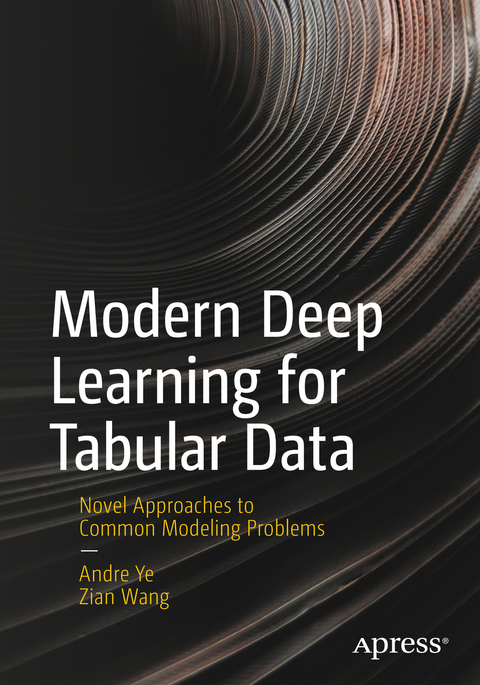
Modern Deep Learning for Tabular Data
Apress (Verlag)
978-1-4842-8691-3 (ISBN)
Part I of the book offers a rigorous overview of machine learning principles, algorithms, and implementation skills relevant to holistically modeling and manipulating tabular data. Part II studies five dominant deep learning model designs – Artificial Neural Networks, Convolutional Neural Networks, Recurrent Neural Networks, Attention and Transformers, and Tree-Rooted Networks – through both their ‘default’ usage and their application to tabular data. Part III compounds the power of the previously covered methods by surveying strategies and techniques to supercharge deep learning systems: autoencoders, deep data generation, meta-optimization, multi-model arrangement, and neural network interpretability. Each chapter comes with extensive visualization, code, and relevant research coverage.
Modern Deep Learning for Tabular Data is one of the first of its kind – a wide exploration of deep learning theory and applications to tabular data, integrating and documenting novel methods and techniques in the field. This book provides a strong conceptual and theoretical toolkit to approach challenging tabular data problems.
What You Will Learn
Important concepts and developments in modern machine learning and deep learning, with a strong emphasis on tabular data applications.
Understand the promising links between deep learning and tabular data, and when a deep learning approach is or isn’t appropriate.
Apply promising research and unique modeling approaches in real-world data contexts.
Explore and engage with modern, research-backed theoretical advances on deep tabular modeling
Utilize unique and successful preprocessing methods to prepare tabular data for successful modelling.
Who This Book Is ForData scientists and researchers of all levels from beginner to advanced looking to level up results on tabular data with deep learning or to understand the theoretical and practical aspects of deep tabular modeling research. Applicable to readers seeking to apply deep learning to all sorts of complex tabular data contexts, including business, finance, medicine, education, and security.
Andre Ye is a deep learning researcher with a focus on building and training robust medical deep computer vision systems for uncertain, ambiguous, and unusual contexts. He has published another book with Apress, Modern Deep Learning Design and Applications, and writes short-form data science articles on his blog. In his spare time, Andre enjoys keeping up with current deep learning research and jamming to hard metal. Andy Wang is a researcher and technical writer passionate about data science and machine learning. With extensive experiences in modern AI tools and applications, he has competed in various professional data science competitions while gaining hundreds and thousands of views across his published articles. His main focus lies in building versatile model pipelines for different problem settings including tabular and computer-vision related tasks. At other times while Andy is not writing or programming, he has a passion for piano and swimming.
Part 1: Machine Learning and Tabular Data.- Chapter 1 – Introduction to Machine Learning.- Chapter 2 – Data Tools.- Part 2: Applied Deep Learning Architectures.- Chapter 3 – Artificial Neural Networks.- Chapter 4 – Convolutional Neural Networks.- Chapter 5 – Recurrent Neural Networks.- Chapter 6 – Attention Mechanism.- Chapter 7 – Tree-based Neural Networks.- Part 3: Deep Learning Design and Tools.- Chapter 8 – Autoencoders.- Chapter 9 – Data Generation.- Chapter 10 – Meta-optimization.- Chapter 11 – Multi-model arrangement.- Chapter 12 – Deep Learning Interpretability.- Appendix A.
| Erscheinungsdatum | 10.01.2023 |
|---|---|
| Zusatzinfo | 433 Illustrations, color; 209 Illustrations, black and white; XXVIII, 842 p. 642 illus., 433 illus. in color. |
| Verlagsort | Berkley |
| Sprache | englisch |
| Maße | 178 x 254 mm |
| Themenwelt | Mathematik / Informatik ► Informatik ► Datenbanken |
| Informatik ► Theorie / Studium ► Algorithmen | |
| Informatik ► Theorie / Studium ► Künstliche Intelligenz / Robotik | |
| Schlagworte | convolutional neural networks • Deep learning • machine learning • neural network • NumPy • Pandas • Recurrent Neural Networks • Tabular Data • Times Series Data • Transformers |
| ISBN-10 | 1-4842-8691-X / 148428691X |
| ISBN-13 | 978-1-4842-8691-3 / 9781484286913 |
| Zustand | Neuware |
| Informationen gemäß Produktsicherheitsverordnung (GPSR) | |
| Haben Sie eine Frage zum Produkt? |
aus dem Bereich


